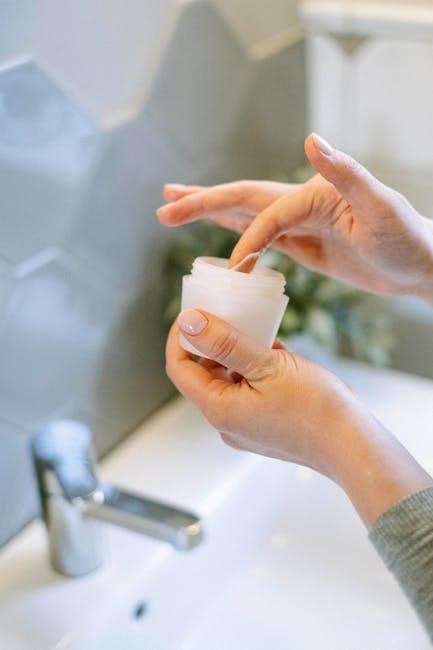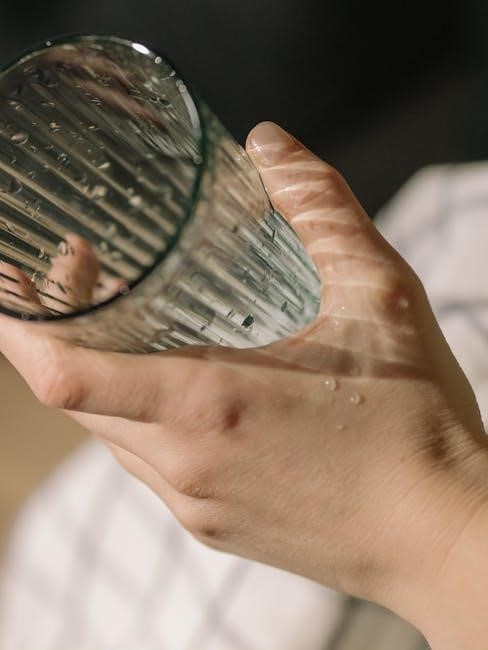Understanding Laundry Care Symbols
Laundry care symbols guide proper washing, drying, and ironing. They ensure fabrics last longer and prevent damage. These universal pictograms are essential for maintaining garment quality and safety.
- They provide clear instructions for care and maintenance.
- Symbols are designed to be universally understood.
- They help prevent fabric damage and extend garment life.
1.1 The Importance of Care Labels
Care labels provide essential guidance for maintaining garments. They ensure fabrics are treated correctly, preventing damage and extending their lifespan. These labels use universal symbols, making them accessible to everyone, regardless of language barriers. By following care instructions, consumers can avoid common mistakes like using improper temperatures or incorrect washing methods. This not only preserves the quality of clothes but also ensures safety, as some fabrics may shrink, lose color, or deteriorate if not cared for properly. Understanding care labels is key to keeping your wardrobe in its best condition.
- Prevent fabric damage and color fading.
- Ensure safety and longevity of garments.
- Provide clear, universal instructions for all users.
1.2 Universal Symbols for Washing, Drying, and Ironing
Universal care symbols provide clear guidance for washing, drying, and ironing garments. These symbols, often depicted as pictograms, are designed to be understood globally, regardless of language. Washing symbols include a washtub, with dots indicating temperature and lines for cycle intensity. Drying symbols feature a square, with variations showing tumble dry or line dry options and heat levels. Ironing symbols use an iron icon, with dots signaling temperature settings. These standardized symbols ensure proper care, preventing damage and maintaining fabric quality. They simplify laundry tasks, making it easier for everyone to follow care instructions accurately.
- Washing: Tub icon with temperature and cycle details.
- Drying: Square symbol with heat and method indicators.
- Ironing: Iron icon with temperature dots for guidance.

Washing Instructions
Washing instructions guide how to clean garments safely. Symbols indicate machine or hand wash options, water temperature, and cycle intensity. Dots and lines under tub icons specify settings. Always check labels for best results.
- Machine wash symbols show allowed temperatures and cycles.
- Hand wash symbols recommend gentle cleaning methods.
2.1 Machine Wash Symbols
Machine wash symbols indicate if a garment can be washed in a washing machine. A tub icon with water represents machine washing. Dots inside the tub signify temperature: one dot for low heat, two for medium, and three for high. Lines underneath the tub indicate cycle intensity—short lines for delicate fabrics and long lines for heavier cycles. Additional symbols, like a hand or number, may specify gentle cycles or maximum temperature. Always check these symbols to ensure safe and effective washing. Proper use extends fabric life and maintains garment quality.
- The tub icon with water indicates machine washing is allowed.
- Dots inside the tub specify temperature settings.
- Lines under the tub guide cycle selection based on fabric type.
2.2 Hand Wash Symbols
Hand wash symbols indicate garments should be washed gently by hand. The symbol typically features a tub with hands or a hand icon inside. Dots below or above the tub denote temperature: one dot for cold water, two for warm, and three for hot. A line beneath the tub suggests gentle agitation, while a cross or “X” prohibits hand washing. These symbols ensure delicate fabrics are treated with care, preventing damage and maintaining texture. Always follow hand wash instructions to preserve garment quality and extend lifespan.
- The hand wash symbol ensures gentle cleaning for delicate fabrics.
- Dots indicate safe water temperatures for washing.
- A line under the tub suggests gentle agitation only.
2.3 Temperature Indicators (Lines and Dots)
Temperature indicators on care labels guide water temperature for washing. Dots inside the tub symbol represent heat levels: one dot for cold, two for warm, and three for hot. Lines beneath the tub indicate maximum temperature tolerance. A single horizontal line means gentle or cold wash, while multiple lines suggest higher heat resistance. These symbols ensure fabrics are washed safely, preventing shrinkage or color fading. Always match the dots and lines to your washing machine settings for optimal care and fabric longevity.
- Dots indicate water temperature levels for washing.
- Lines under the tub specify maximum heat tolerance.
- Matching symbols to machine settings prevents fabric damage.
2.4 Wash Cycle Selection Guide
The wash cycle selection guide on care labels helps choose the right washing machine settings. Symbols like a tub with lines or numbers indicate recommended cycles. A single horizontal line under the tub suggests a gentle or delicate cycle, while multiple lines or a number inside the tub indicate a standard or heavy-duty cycle. Dots may further specify temperature settings. Matching the symbol to your machine ensures fabrics are treated correctly, preserving their quality and extending longevity. Always refer to this guide to select the optimal cycle for your garments.
- Lines under the tub symbol indicate cycle intensity.
- Numbers or dots specify temperature and cycle type.
- Matching symbols to machine cycles prevents damage.

Drying Instructions
Drying instructions specify methods like tumble drying, line drying, or air drying. Symbols indicate heat settings and restrictions to prevent fabric damage and ensure longevity.
- Tumble dry symbols with dots denote heat levels.
- A crossed-out symbol means tumble drying is prohibited.
- Line and air dry symbols recommend natural drying.
3.1 Tumble Dry Symbols
Tumble dry symbols indicate if garments can be machine dried. A square with a circle inside is the universal symbol. Dots inside the square represent heat levels: one dot for low, two for medium, and three for high heat. If the symbol is crossed out, tumble drying is not allowed. These symbols ensure safe drying methods, preventing fabric shrinkage or damage. Always check the number of dots to select the appropriate dryer setting. Properly following tumble dry instructions extends the life of your clothes and maintains their quality. This ensures fabrics remain intact and garments look their best after drying.
- A square with a circle inside indicates tumble drying is allowed.
- Dots inside the square signify heat levels for drying.
- A crossed-out symbol means tumble drying is prohibited.
3.2 Line Dry and Air Dry Symbols
Line dry and air dry symbols guide how to dry garments without machine heat. A square with a horizontal line indicates line drying, while a square alone means air drying. These symbols suggest avoiding tumble dryers to prevent fabric damage. Line drying preserves the shape and texture of clothes, while air drying is gentler on delicate fabrics. If a crossed-out tumble dry symbol appears, it emphasizes air drying as the preferred method. These instructions help maintain fabric integrity and extend garment life, especially for sensitive or synthetic materials. Always follow these symbols to ensure proper drying techniques.
- A square with a line indicates line drying.
- A square alone signifies air drying.
- These methods prevent fabric damage and shrinkage.
3.3 Heat Settings for Drying (Dots)
Heat settings for drying are indicated by dots within a square symbol. One dot means low heat, two dots indicate medium heat, and three dots signify high heat. These symbols guide the optimal temperature for drying fabrics. A crossed-out symbol, however, means no heat should be used. Proper heat selection prevents fabric damage, shrinkage, or discoloration. Always adhere to these guidelines to maintain garment quality and extend its lifespan. These symbols ensure safe drying practices for various fabric types, ensuring clothes retain their texture and appearance.
- One dot: Low heat setting.
- Two dots: Medium heat setting.
- Three dots: High heat setting.
- Crossed-out symbol: No heat allowed.
3.4 Avoiding Tumble Dry Restrictions
A crossed-out tumble dry symbol indicates that certain fabrics should not be machine dried. This precaution prevents shrinkage, damage, or loss of texture. Always check for this symbol to avoid ruining delicate or special-care items. If tumble drying is restricted, opt for air drying or line drying instead. For fabrics like wool or silk, reshaping before air drying helps maintain their form. Properly adhering to these restrictions ensures garments remain in excellent condition and last longer. Ignoring these guidelines can lead to irreversible damage, making it essential to follow care instructions carefully.
- Avoid tumble drying for fabrics with crossed-out symbols.
- Opt for air or line drying as alternatives.
- Reshape delicate fabrics before drying.

Bleaching Instructions
Bleaching symbols indicate whether bleach is allowed. A triangle means bleach can be used, while a crossed triangle prohibits it. Always follow these guidelines to avoid fabric damage.
- Triangle symbol indicates bleach is allowed.
- Prohibited if the triangle is crossed out.
4.1 Bleaching Allowed Symbols
The triangle symbol indicates that bleaching is allowed. If the triangle is empty, chlorine bleach can be used. A triangle with an “X” prohibits chlorine but allows color-safe bleach. Always check fabric suitability before bleaching. Natural fibers like cotton can usually handle chlorine, while synthetics may require color-safe options. Spot testing is recommended to ensure colorfastness. Some labels specify “Bleach When Needed” for flexibility. Following these guidelines ensures safe bleaching and prevents color fading or fabric damage.
- Triangle alone: Chlorine bleach allowed.
- Triangle with “X”: Use color-safe bleach only.
4.2 Bleach Type Indicators (Triangle Symbols)
Bleach type indicators are represented by triangle symbols on care labels. An empty triangle means chlorine bleach is safe for colored fabrics. A triangle with a diagonal line or “X” indicates only color-safe bleach should be used. For wool or silk, a triangle with a line underneath suggests oxygen bleach. These symbols ensure proper bleach selection to maintain color vibrancy and fabric integrity. Always check fabric type compatibility and test a small area first to avoid damage or discoloration.
- Empty triangle: Chlorine bleach allowed.
- Triangle with “X”: Use color-safe bleach only.
- Triangle with line: Oxygen bleach recommended.
4.3 Prohibited Bleaching Symbols
A triangle symbol with a diagonal line or “X” indicates that bleaching is prohibited. This symbol warns against using any type of bleach, as it may damage the fabric or cause discoloration. Always check the label for this symbol to avoid ruining your garments. Ignoring it can lead to irreversible damage or color loss. If bleaching is prohibited, consider alternative cleaning methods like spot cleaning or using color-protecting detergents. Adhering to this symbol ensures the fabric remains intact and maintains its appearance.
- Triangle with “X” means no bleaching allowed.
- Using bleach despite this symbol can harm fabrics.
- Opt for alternative cleaning methods if prohibited.
- Temperature dots on iron symbols specify heat levels.
- Steam symbols indicate if steaming is permitted.
- Circle symbol: Suitable for dry cleaning.
- Letters inside: Specify cleaning solvents.
- Additional markings: Provide detailed care guidance.
- Circle with water droplet: Indicates wet cleaning suitability.
- Lines or dots: Specify gentle or vigorous cycles.
- Restrictions: May prohibit soaking or wringing.
- Prevents shrinkage and color fading.
- Protects delicate materials from damage.
- Ensures safe cleaning and fabric longevity.
- Prevents fabric damage and color loss.
- Ensures proper care for delicate materials.
- Maintains garment quality and longevity.

Ironing and Steaming Instructions
Ironing symbols indicate temperature settings, with dots showing heat levels. A steam symbol allows steaming. These guide fabric care, preventing damage and ensuring proper fabric treatment.
5.1 Ironing Temperature Symbols
Ironing temperature symbols guide the appropriate heat settings for fabrics. A circle with dots indicates temperature levels: one dot for low, two for medium, and three for high heat. These symbols ensure fabrics are ironed safely. Special symbols may denote specific fabric requirements, like silk or wool. Always match the iron’s temperature to the symbol on the care label to prevent damage. These indicators are crucial for maintaining fabric integrity and extending garment life. Proper temperature use ensures optimal results and avoids irreversible fabric harm. Always consult the label for precise guidance on ironing temperatures.
5.2 Steam Ironing Indicators

Steam ironing indicators are symbols that guide the use of steam during ironing. These symbols often appear as a circle with dots and a vertical line, indicating steam compatibility. Some fabrics require steam for effective wrinkle removal, while others may be damaged by it. The symbol may also specify steam settings or restrictions. Always check the label to ensure safe use of steam on your garments. This helps maintain fabric quality and prevents damage. Steam can enhance ironing efficiency but must be used cautiously based on the care label’s instructions. Proper steam usage ensures optimal results and fabric longevity;

Professional Cleaning Instructions
Professional cleaning symbols indicate if garments require dry or wet cleaning. These symbols guide the use of specific cleaning methods to preserve fabric quality and appearance.
6.1 Dry Cleaning Symbols
Dry cleaning symbols indicate garments requiring professional cleaning. A circle symbol means dry cleaning is suitable. Variations include letters like ‘P’ for perchloroethylene or ‘W’ for wet cleaning. Additional lines or dots provide specific instructions. These symbols ensure proper care, preventing fabric damage. They guide professionals in selecting safe cleaning methods, maintaining garment quality and appearance. Always check these symbols before cleaning to avoid irreversible damage.

6.2 Wet Cleaning Symbols
Wet cleaning symbols, often represented by a circle with a water droplet or wave, indicate garments that can be cleaned using water-based methods. These symbols may include additional lines or dots to specify gentle cycles or agitation levels. Wet cleaning is a gentler alternative to dry cleaning, suitable for delicate fabrics. Some symbols may include restrictions, such as no soaking or wringing. Properly interpreting these symbols ensures safe cleaning and maintains fabric integrity. Wet cleaning is ideal for fabrics that cannot withstand traditional washing or dry cleaning methods.
Importance of Adhering to Care Symbols
Adhering to care symbols prevents fabric damage and extends garment life. Proper washing, drying, and ironing ensure clothes maintain quality and appearance. Ignoring symbols risks irreversible harm.
7.1 Preventing Damage to Fabrics
Following care symbols prevents fabric damage, ensuring clothes maintain their quality. Ignoring symbols can lead to shrinkage, color fading, or material degradation. Proper washing, drying, and ironing preserve fabric integrity. High heat or incorrect cycles can harm delicate materials. Symbols guide safe cleaning methods, avoiding damage. For example, the tumbling dry symbol with heat settings prevents overheating. Adhering to these instructions safeguards fabrics, ensuring longevity. Neglecting care labels risks irreversible harm, making compliance essential for fabric preservation.
7.2 Extending the Life of Garments
Adhering to care symbols is essential for extending garment life. Proper washing, drying, and ironing prevent damage like shrinkage and fading. Symbols guide temperature and cycle selection, protecting fabrics from harm. Delicate materials require gentle care, while others need specific treatments. Following these instructions maintains color vibrancy and fabric integrity. Neglecting them can lead to premature wear, ruining clothes. By understanding and following care symbols, you ensure garments remain in excellent condition longer, avoiding costly replacements.
